Europa - national archaeological discoveries
Title:Europa - national archaeological discoveries
Date of Issue: 24.04.2025.
Author: Nebojsa Djumic
Type edition: commemorative
Printing techniques: multicolour offset
Sheet: 8+1 и блок
Paper: muflep 100g
Printing House: Blicdruk, Sarajevo
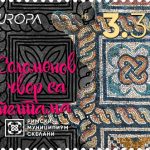 Motive: mosaic Solomon`s knot
Motive: mosaic Solomon`s knot
Catalogue no.: 993
Perforation: 13 3/4
Face value: 3.30 BAM
Quantity: 8 000
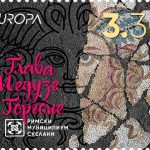 Motive: Mosaic head of medusa Gorgona
Motive: Mosaic head of medusa Gorgona
Catalogue no.: 994
Perforation: 13 3/4
Face value: 3.30 BAM
Quantity: 8 000
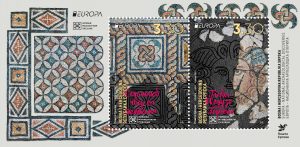 Motive: Mosaics Solomon`s knot and head of medusa Gorgona
Motive: Mosaics Solomon`s knot and head of medusa Gorgona
Каталошки број: 995 и 996
Perforation: 13 3/4
Face value: 6.60 BAM
Quantity: 8 000
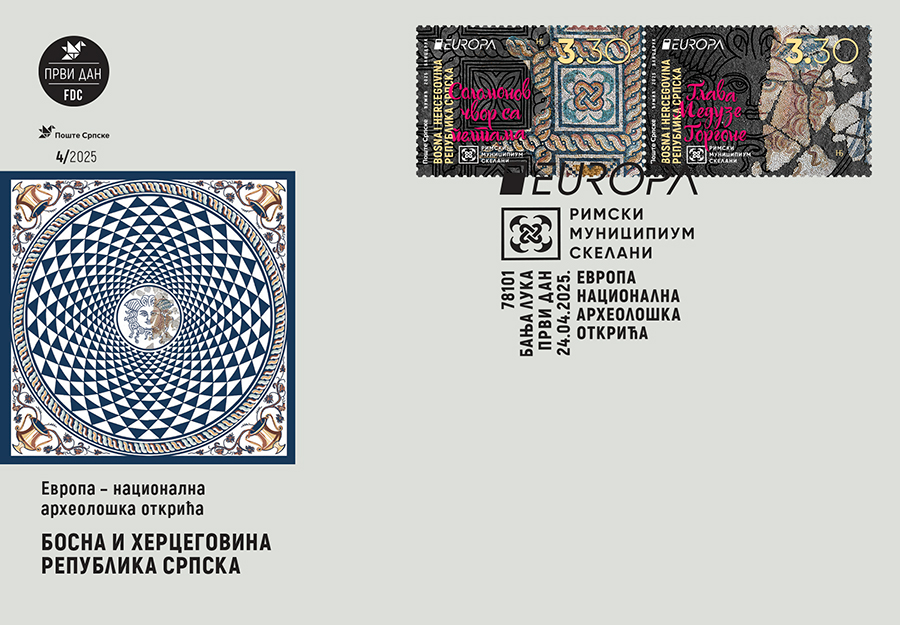
At the one hundred and fifty-ninth kilometer from the confluence of the Piva and Tara rivers and the origin of the Drina River, on the bend that the river makes around the Osata mountain range in the middle Podrinje, is the town of Skelani. The region is rich in natural and mineral resources, which contributed to the development of a Roman settlement here from the 1st to the 4th century. Excellent urban planners, builders and craftsmen, the Romans, left behind numerous buildings and monuments, the remains of which can still be seen today. One of the inscriptions mentioning the city councilordo decurionumwas found in Skelani, which suggests that the center of the Roman Municipium Malvesiatium was located here.
The first archaeological excavations in Skelani were carried out by Carl Patsch back in 1896. On that occasion, he discovered and explored two early Christian churches, a necropolis and a brickyard, and in the wider area of Skelani he collected over 80 Roman monuments. His further efforts were prevented by the Drina River, which buried everything he had collected and excavated in a major flood.
A hundred years later, archaeologists returned to Skelani. Under the leadership of Mirko Babic, excavations were carried out in 2008 at four locations: “Community Center”, “Branko`s Field”, “Baba Anka`s Yard” and in the “Entrence of Serbian Orthodox Church”. Remains of ancient buildings were discovered at all four locations, and the finds of Roman floor mosaics at the “Community Centre” site and 30 Roman monuments at the “Baba Anka`s Yard” site were particularly valuable. After these discoveries, the National Assembly of the Republic of Srpska declared the archaeological complex in Skelani a cultural asset of exceptional importance. The Public Institution Archaeological Museum “Roman municipium” Skelani was soon established, with the task of taking care of the protected complex.
In the following period, was almost completely explored, villa urbana, in which a corridor with floor mosaics dominated by floral and geometric motifs was discovered. While in a room interpreted as a dining room, a mosaic was discovered whose central motif was a medallion with the figure of the Gorgon Medusa.
Author: Nebojsa Djumic
Publisher: Poste Srpske a.d. Banjaluka
Сарадња: Археолошки музеј „Римски муниципиум“ Скелани и Републички завод за заштиту културно-историјског и природног насљеђа
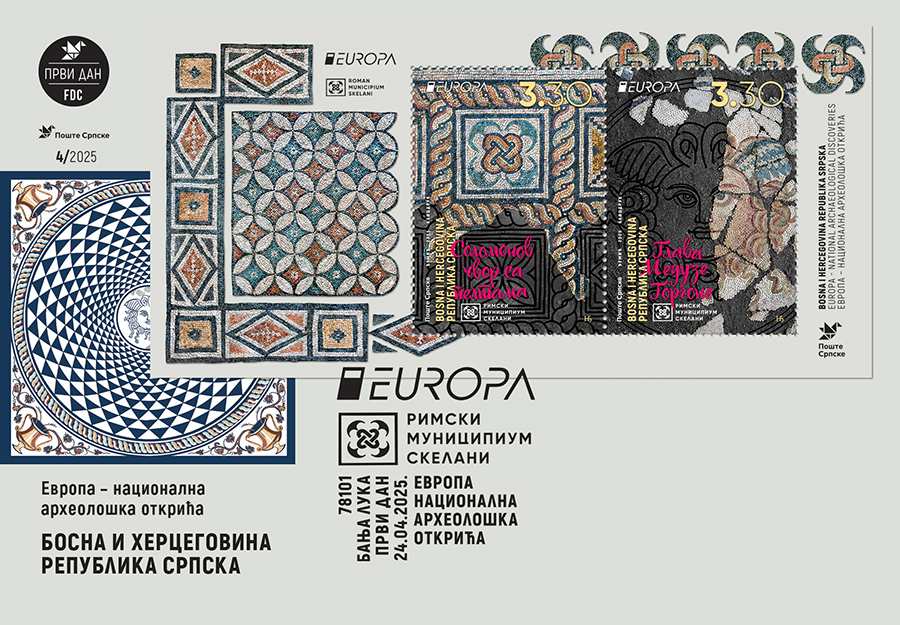
At the one hundred and fifty-ninth kilometer from the confluence of the Piva and Tara rivers and the origin of the Drina River, on the bend that the river makes around the Osata mountain range in the middle Podrinje, is the town of Skelani. The region is rich in natural and mineral resources, which contributed to the development of a Roman settlement here from the 1st to the 4th century. Excellent urban planners, builders and craftsmen, the Romans, left behind numerous buildings and monuments, the remains of which can still be seen today. One of the inscriptions mentioning the city councilordo decurionumwas found in Skelani, which suggests that the center of the Roman Municipium Malvesiatium was located here.
The first archaeological excavations in Skelani were carried out by Carl Patsch back in 1896. On that occasion, he discovered and explored two early Christian churches, a necropolis and a brickyard, and in the wider area of Skelani he collected over 80 Roman monuments. His further efforts were prevented by the Drina River, which buried everything he had collected and excavated in a major flood.
A hundred years later, archaeologists returned to Skelani. Under the leadership of Mirko Babic, excavations were carried out in 2008 at four locations: “Community Center”, “Branko`s Field”, “Baba Anka`s Yard” and in the “Entrence of Serbian Orthodox Church”. Remains of ancient buildings were discovered at all four locations, and the finds of Roman floor mosaics at the “Community Centre” site and 30 Roman monuments at the “Baba Anka`s Yard” site were particularly valuable. After these discoveries, the National Assembly of the Republic of Srpska declared the archaeological complex in Skelani a cultural asset of exceptional importance. The Public Institution Archaeological Museum “Roman municipium” Skelani was soon established, with the task of taking care of the protected complex.
In the following period, was almost completely explored, villa urbana, in which a corridor with floor mosaics dominated by floral and geometric motifs was discovered. While in a room interpreted as a dining room, a mosaic was discovered whose central motif was a medallion with the figure of the Gorgon Medusa.
Author: Nebojsa Djumic
Publisher: Poste Srpske a.d. Banjaluka
Сарадња: Археолошки музеј „Римски муниципиум“ Скелани и Републички завод за заштиту културно-историјског и природног насљеђа



